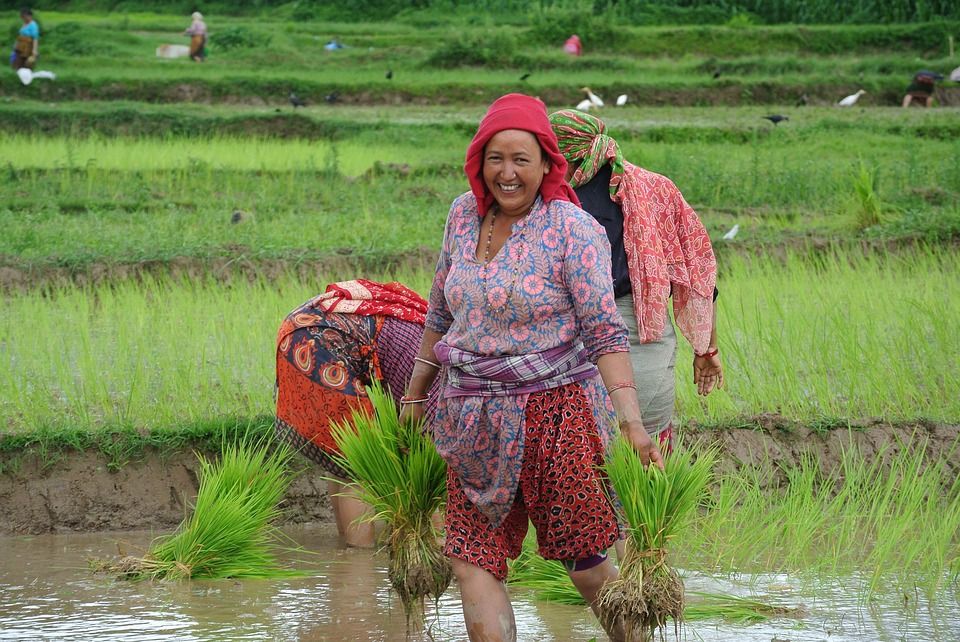Because of the intense rains, Nepal has seen one of the quickest rates of paddy transplantation in several decades.

This year's monsoon rains have caused a great deal of death and devastation. However, they also have some positive news.
Nepal's "above-normal rainfall" has allowed for one of the quickest rates of paddy transplantation in many years.
As of Wednesday, the Department of Agriculture reports that 96% of paddy transplants had been completed.
"Arun Kafle, deputy director general of the department, stated that transplantation has been finished on 96% of the paddy fields, though specifics are still pending."
He noted that because of the plentiful rainfall, farmers in Nepal have started transplanting summer paddy quickly, increasing the likelihood of a bumper crop.
This transplantation rate is thought to be the fastest in many years. "There has been constant rainfall, which is beneficial for crops, especially paddy."
According to agronomic experts, the Madhesh province has overtaken its neighbor, Koshi province, in terms of paddy transplantation for the first time, surpassing the national average as well, because of the frequent and abundant monsoon rains.
In the Madhesh province, insufficient rainfall has long been a persistent issue. Local farmers are facing more challenges as a result of a large-scale exodus of young people to other countries, which has resulted in a labor shortage for agricultural tasks.
According to agronomic specialists, transplanting dates vary by location.
There are certain benefits to early transplantation.
According to agronomists, early transplanted paddy largely evades pest assault, which lowers the additional input costs associated with applying pesticides.
Additionally, it facilitates a timely transition to the following crop cycle on the same area.
"The primary benefit of early transplantation is the expansion of paddy fields," agricultural specialist and AgriGreen Nepal executive director Rajendra Uprety stated. "The month that follows transplanting is crucial for plant growth. Production will increase if the growing season experiences consistent rains.
He claimed that the abuse of urea has resulted in a nutrition shortfall in a few places in eastern Nepal. Overuse of urea can quickly harm other fertilizers and result in malnutrition.
Farmers use urea without balancing its use with other nutrients like compost and potash since it is inexpensive. This propensity has caused grave issues in numerous regions of Nepal.
The transplantation dates in Nepal vary based on location and rainfall availability. By mid-June, paddy transplantation in the upper slopes is finished. Depending on the availability of water, it starts in early July and lasts until early September in Tarai, the nation's food basket.
Seventy-one percent of the rice acreage is in the plains. Twenty-five percent are on the hills, and four percent are in the mountainous area.
Low rainfall in Madhesh Province last year caused transplantation to be delayed, which had an impact on productivity and output.
The process was finished on 92.4 percent of the 1.39 million hectares of land that may be used for paddy production as of Sunday, according to the Department of Agriculture.
At the same time last year, 78% of paddy transplants were made.

The monsoon this year arrived in Nepal on June 10, three days ahead of schedule, as per the Meteorological Forecasting Division. It came in from the east.
The rainy season is intimately related to Nepal's economic health. The Rs 5.7 trillion economy of Nepal, which is primarily based on agriculture, depends on rainwater. Rain feeds about two thirds of the farmlands.
Over 80 percent of the country's yearly precipitation falls in the four months from June to September.
The amount and distribution of monsoon rainfall across the nation determine how much rice is produced, the staple crop of the nation. Rainfall also replenishes reservoirs and groundwater, which are essential for producing electricity and drinking.
Madhesh Province had the lowest transplantation rate last year, at 58.8%, according to the agency. This year, it increased to 92 percent. As of Wednesday, transplantation on 352,443 hectares of the Madhesh, which controls the majority of the paddy fields (383,150 hectares), was finished.
"Madhesh's increased productivity boosts the country's total output. Thus, Nepal might have a record-breaking paddy crop this year provided the rains persist and fertilizer supplies are enough, according to Kafle. From the middle of October to November, paddy is harvested.
At 99.6% of its 174,576 hectares, Sudurpaschim Province had the greatest transplantation rate; it was followed by Karnali Province (96.9% of 41,904 hectares), Madhesh Province (92.1%), and Gandaki Province (91.9%) of 96,053 hectares.
At 99.6% of its 174,576 hectares, Sudurpaschim Province had the greatest transplantation rate; it was followed by Karnali Province (96.9% of 41,904 hectares), Madhesh Province (92.1%), and Gandaki Province (91.9%) of 96,053 hectares.
The province of Lumbini has reported a rate of 91.3 percent on 311,643 hectares.
Of Bagmati Province's 112,273 hectares, 90.8 percent have undergone transplantation. With 90.7 percent of 276,386 hectares transplanted, the Koshi province had the lowest percentage of transplantation.
Tens of thousands of farmers in Nepal depend on paddy as their main source of revenue from agriculture. Economists predict that the high output will boost the economy and reduce inflation.




